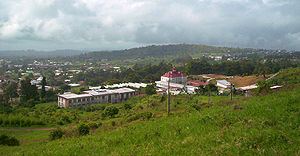| Revision as of 02:32, 23 January 2017 edit124.72.154.250 (talk)No edit summary← Previous edit | Revision as of 02:34, 23 January 2017 edit undoMarlo Jonesa (talk | contribs)1,587 editsm Reverted 1 edit by 124.72.154.250 (talk) to last revision by John of Reading. (TW)Next edit → | ||
| Line 6: | Line 6: | ||
| |imagesize = 300px | |imagesize = 300px | ||
| |image_caption = Buea from the foot of ] | |image_caption = Buea from the foot of ] | ||
| | image_flag = Flag of the Yemeni Interior Ministry.svg | |||
| |pushpin_map =Cameroon | |pushpin_map =Cameroon | ||
| |mapsize = 150px | |mapsize = 150px | ||
Revision as of 02:34, 23 January 2017
Town and commune in Southwest Region, Cameroon| Buea Gbea | |
|---|---|
| Town and commune | |
 Buea from the foot of Mount Cameroon Buea from the foot of Mount Cameroon | |
| Country | |
| Region | Southwest Region |
| Division | Fako |
| Elevation | 870 m (2,850 ft) |
| Population | |
| • Total | 90,088 (Census) |
| Climate | Cwb |
Buea (Bakweri | Gbea) is the capital of the Southwest Region of Cameroon. The town is located on the eastern slopes of Mount Cameroon and has a population of 90,088 (at the 2005 Census). About 150,000 people live in Buea (including the towns of Bokwaongo, Muea; Bomaka; Tole; Mile 16 (Bolifamba); Mile 17; Mile 15; Mile 14 (Dibanda); Bova; Bonjongo; Likombe; Buasa; and surrounding villages).
History

Buea, originally spelled "Gbea," was founded by Njia Tama Lifanje a hunter who came from the Bomboko Area. Coming from the Bomboko side of the Mountain, he exclaimed in amazement of the new found land "Ebe'eya" meaning literally a "place of happenings". A prominent King of the Bakweri whose headquarters is Buea was chie Kuva Likenye, whose clashes with German troops during the Bakweri resistance remain popular folklore; currently ruled by the Endeleys. Tea growing is an important local industry, especially in Tole. Buea was the colonial capital of German Kamerun from 1901 to 1919, the capital of the Southern Cameroons from 1949 until 1961 and the capital of West Cameroon until 1972, when Ahmadou Ahidjo abolished the Federation of Cameroon. The German colonial administration in Buea was temporarily suspended during the eruption of Mount Cameroon from 28 April – June 1909. Originally, Buea's population consisted mainly of the Bakweri people. However, due to its position as a university town and the regional capital, there are significant numbers of other ethnic groups.
Notable institutions
Buea hosts the University of Buea, Cameroon's first anglophone university. It is the site of several other higher institutes of learning including St Francis schools of Nursing and Midwifery presently known as Biaka University Institute of Buea (BUIB) and one of Cameroon's three Catholic universities.
A handful of colonial era buildings are surviving, notably the palatial former residence of the German governor, Jesko von Puttkamer. Other German colonial buildings are still standing, but some of them suffer from lack of maintenance and old age.
The Nigerian Consulate in anglophone Cameroon and the main operational hub of the Naigahelp medical aid organisation are in Buea.
Geography and climate

Because of its location at the foot of Mount Cameroon, the climate in Buea tends to be humid, with the neighbourhoods at higher elevations enjoying cooler temperatures while the lower neighbourhoods experience a hotter climate. Extended periods of rainfall, characterized by incessant drizzle, which can last for weeks, are common during the rainy season as are damp fogs, rolling off the mountain into the town below.
Transport
Limbe was served by a 600 mm (1 ft 11+5⁄8 in) gauge plantation railway to Limbe, of the West African Planting Society Victoria.
See also
References
- ^ Helders, Stefan. "Buéa". World Gazetteer. Retrieved 2008-03-27.
- http://www.gouverneur-ebermaier.de/english/narrow_gauge_railways.htm
External links
![]() Media related to Buea at Wikimedia Commons
Media related to Buea at Wikimedia Commons
- Mount Cameroon Inter-communal Ecotourism Board - formerly known as Mount Cameroon Ecotourism Organisation, abbreviated as Mount CEO
| Capitals of the Regions of Cameroon | |
|---|---|